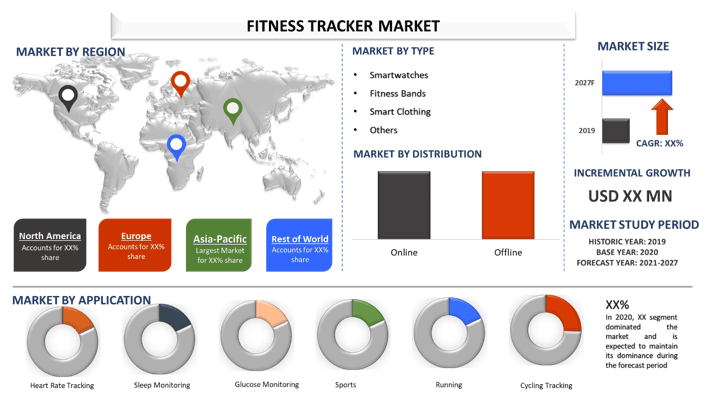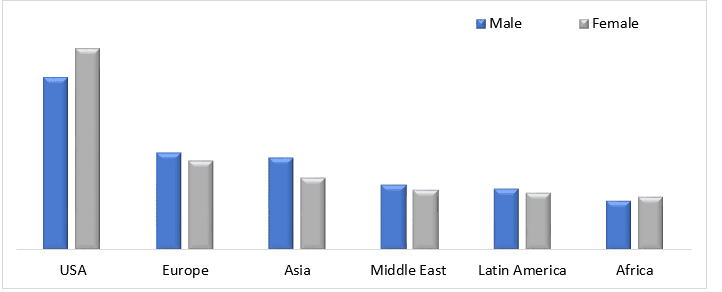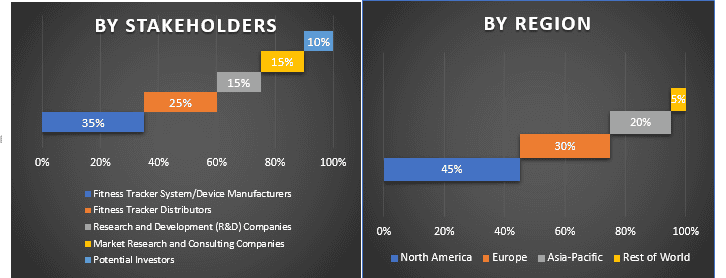- Home
- About Us
- Industry
- Services
- Reading
- Contact Us
Fitness Tracker Market: Current Analysis and Forecast (2021-2027)
Emphasis on Type (Smartwatches, Fitness Bands, Smart Clothing, Others); Application (Heart Rate Tracking, Sleep Monitoring, Glucose Monitoring, Sports, Running, Cycling Tracking); Distribution (Online, Offline); Region/Country

The Fitness Tracker Market was valued at US$ 36 billion in 2020 and is expected to grow at a CAGR of 16% during the forecast period (2021-2027). Fitness Tracker is mainly used to monitor and record fitness-related physical activities, for example, distance walked, steps taken, heartbeat monitoring, sleep duration, and others. The wireless connectivity medium is employed for the connection of these devices with computers or smartphones. The advancements in technologies and innovation are expected to boost the market growth in the upcoming period. In September 2019, Apple unveiled the apple watch series 5, with many advanced features such as onboard tracking of GPS and heart rate with high accuracy. From the Fitbit to Apple’s fitness tracker: wearable technology is becoming highly popular all over the world. The consumers living in high disposable countries are at the forefront of purchasing fitness trackers, ownership reaching over 30% in Spain, Turkey, and the USA. The high adoption of fitness trackers and smartwatches in Western countries is boosting the market growth. There are many opportunities for app developers and wearable producers in speedily developing countries such as China (28.1%) and Russia (23.8%) which further intensifies the market growth. Worldwide, the United States ranks first in terms of wearable tech penetration, 35.5% of affluent Americans have a fitness tracker in their household, such as the Fitbit or Garmin Vivofit. Around 15.5% of affluent Americans own a smartwatch like the Apple Watch or Samsung Gear.
Wearables Ownership by Sex, 2019

Insights Presented in the Report
“Amongst Type, Smartwatches segment holds the major share.”
Based on Type, the market is fragmented into Smartwatches, Fitness Bands, Smart Clothing, and Others. The Smartwatches segment dominated the market in 2020 and is expected to grow at lucrative during the forecasted period owing to increasing prevalence to track physical activities, and user-friendly usability. In addition, the constant development of fitness tacker products, in terms of functions and features, is further driving the market growth. Smartwatches not only provide high-end activity tracking features but also an interactive operating system for the user which fosters segment growth.
“Amongst Distribution, Online segment holds the major share.”
Based on Distribution, the market is bifurcated into Online and Offline. The Online segment dominated the market in 2020 and is expected to grow at lucrative during the forecasted period. The increasing penetration of the internet and smartphones all over the world is driving the segment growth. In addition, the increasing popularity of e-commerce platforms owing to quick service and high convenience offered by them intensifies the market growth.
“Amongst Application, the Running segment is anticipated to grow at the highest CAGR during the analyzed period.”
Based on Application, the market is bifurcated into Heart Rate Tracking, Sleep Monitoring, Glucose Monitoring, Sports, Running, and Cycling Tracking. The Running segment dominated the market in 2020 and is expected to grow at lucrative during the forecasted period owing to rising competition and consumer preference. Few Fitness tracker devices such as Nurvv run by Nurrv and Forerunner by Garmin are mainly designed for numerous sports applications, offering various features such as Hill Splitter, lap counter, and goal setting. The capability of the IoT to monitor the progression of the disease and other health conditions, make it an effective tool in the healthcare sector. Recently, several IoT devices have been invented for the monitoring of the health conditions of patients remotely. For instance, smartwatches like the apple watch help to monitor the heart rate, and ADAMM (Automated Device for Asthma Monitoring and Management), a wearable asthma monitor helps to monitor the symptoms of an asthma attack before its occurrence.
“North America region signifies one of the largest markets and is expected to be the fastest-growing markets of Fitness Tracker market.”
For a better understanding of the market adoption of Fitness Tracker, the market is analyzed based on its worldwide presence in the countries such as North America (United States, Canada, and the Rest of North America), Europe (Germany, France, Spain, United Kingdom and Rest of Europe), Asia-Pacific (China, Japan, India, Australia, and Rest of APAC), and Rest of World. North America will dominate the Fitness Tracker market on account of the owing to the rising awareness and adoption of fitness trackers. Furthermore, the increasing incidents of health issues related to sedentary lifestyles, the growing penetration of smartphones and the internet, and the advent of innovative products by key market players in the North American region will drive the market growth. Some of the major players operating in the market include Adidas AG, Apple Inc., Fitbit Inc., Garmin Ltd, Google Inc, Jawbone Inc, LG Electronics Inc, Nike Inc, Pebble Technology Corp, and Qualcomm Inc. Several M&As along with partnerships have been undertaken by these players to boost their presence in different regions.
Reasons to buy this report:
- The study includes market sizing and forecasting analysis validated by authenticated key industry experts
- The report presents a quick review of overall industry performance at one glance
- The report covers an in-depth analysis of prominent industry peers with a primary focus on key business financials, product portfolio, expansion strategies, and recent developments
- Detailed examination of drivers, restraints, key trends, and opportunities prevailing in the industry
- The study comprehensively covers the market across different segments
- Deep dive regional level analysis of the industry
Customization Options:
The Fitness Tracker market can further be customized as per the requirement or any other market segment. Besides this, UMI understands that you may have your own business needs, hence feel free to connect with us to get a report that completely suits your requirements.
Table of Content
Analyzing the historical market, estimation of the current market, and forecasting the future market of the Global Fitness Tracker market were the three major steps undertaken to create and analyze the adoption of Fitness Tracker for the different applications such as Heart Rate Tracking, Sleep Monitoring, Glucose Monitoring, Sports, Running, and Cycling Tracking. Exhaustive secondary research was conducted to collect the historical market numbers and estimate the current market size. Secondly, to validate these insights, numerous findings and assumptions were taken into consideration. Moreover, exhaustive primary interviews were also conducted, with industry experts across the value chain of the Fitness Tracker sector. Post assumption and validation of market numbers through primary interviews, we employed a top-down/bottom-up approach to forecasting the complete market size. Thereafter, market breakdown and data triangulation methods were adopted to estimate and analyze the market size of segments and sub-segments the industry pertains to.
Detailed methodology is explained below:
Analysis of Historical Market Size
Step 1: In-Depth Study of Secondary Sources:
The detailed secondary study was conducted to obtain the historical market size of the Fitness Tracker through company internal sources such as annual reports & financial statements, performance presentations, press releases, etc., and external sources including journals, news & articles, government publications, competitor publications, sector reports, third-party database, and other credible publications.
Step 2: Market Segmentation:
After obtaining the historical market size of the Fitness Tracker market, we conducted a detailed secondary analysis to gather historical market insights and share for different segments for major regions. Major segments included in the report are Type, Distribution, Application, and Region. Further country-level analyses were conducted to evaluate the overall adoption of Fitness Tracker in every region.
Step 3: Factor Analysis:
After acquiring the historical market size of different segments and sub-segments, we conducted a detailed factor analysis to estimate the current market size of Fitness Tracker. Further, we conducted factor analysis using dependent and independent variables such as the rising number of new product launches.
Current Market Size Estimate & Forecast
Current Market Sizing: Based on actionable insights from the above 3 steps, we arrived at the current market size, key players in the Fitness Tracker Market, and market shares of the segments. All the required percentage shares split, and market breakdowns were determined using the above-mentioned secondary approach and were verified through primary interviews.
Estimation & Forecasting: For market estimation and forecast, weights were assigned to different factors including drivers & trends, restraints, and opportunities available for the stakeholders. After analyzing these factors, relevant forecasting techniques i.e., the top-down/bottom-up approach was applied to arrive at the market forecast about 2027 for different segments and subsegments across the major markets globally. The research methodology adopted to estimate the market size encompasses:
- The industry’s market size, in terms of value (USD) and the adoption rate of Fitness Tracker across the major markets domestically
- All percentage shares, splits, and breakdowns of market segments and sub-segments
- Key players in the Fitness Tracker market in terms of services offered. Also, the growth strategies adopted by these players to compete in the fast-growing market.
Market Size and Share Validation
Primary Research: In-depth interviews were conducted with the Key Opinion Leaders (KOLs) including Top Level Executives (CXO/VPs, Sales Head, Marketing Head, Operational Head, and Regional Head, Country Head, etc.) across major regions. Primary research findings were then summarized, and statistical analysis was performed to prove the stated hypothesis. Inputs from primary research were consolidated with secondary findings, hence turning information into actionable insights.
Split of Primary Participants in Different Regions
Market Engineering
Data triangulation technique was employed to complete the overall market estimation and to arrive at precise statistical numbers of each segment and sub-segment of the Fitness Tracker market. Data was split into several segments & sub-segments post studying various parameters and trends in the areas of Type, Distribution, Application, and Region of the Fitness Tracker market.
Main Objective of the Fitness Tracker Market Study
The current & future market trends of Fitness Tracker were pinpointed in the study. Investors can gain strategic insights to base their discretion for investments from the qualitative and quantitative analysis performed in the study. Current and future market trends were determined the overall attractiveness of the market at a regional level, providing a platform for the industrial participant to exploit the untapped market to benefit as a first-mover advantage. Other quantitative goals of the studies include:
- Analyze the current and forecast market size of Fitness Tracker in terms of value (USD). Also, analyze the current and forecast market size of different segments and sub-segments.
- Segments in the study include areas of Type, Distribution, Application, and Region
- Define and analysis of the regulatory framework for the Fitness Tracker industry
- Analyze the value chain involved with the presence of various intermediaries, along with analyzing customer and competitor behaviors of the industry
- Analyze the current and forecast market size of the Fitness Tracker market for the major region
- Major regions studied in the report include North America (the United States and Canada), Europe (Germany, France, Spain, and United Kingdom), Asia-Pacific (China, Japan, India, and Australia), and the Rest of the World
- Company profiles of the Fitness Tracker market and the growth strategies adopted by the market players to sustain in the fast-growing market
- Deep dive regional level analysis of the industry
Related Reports
Customers who bought this item also bought










